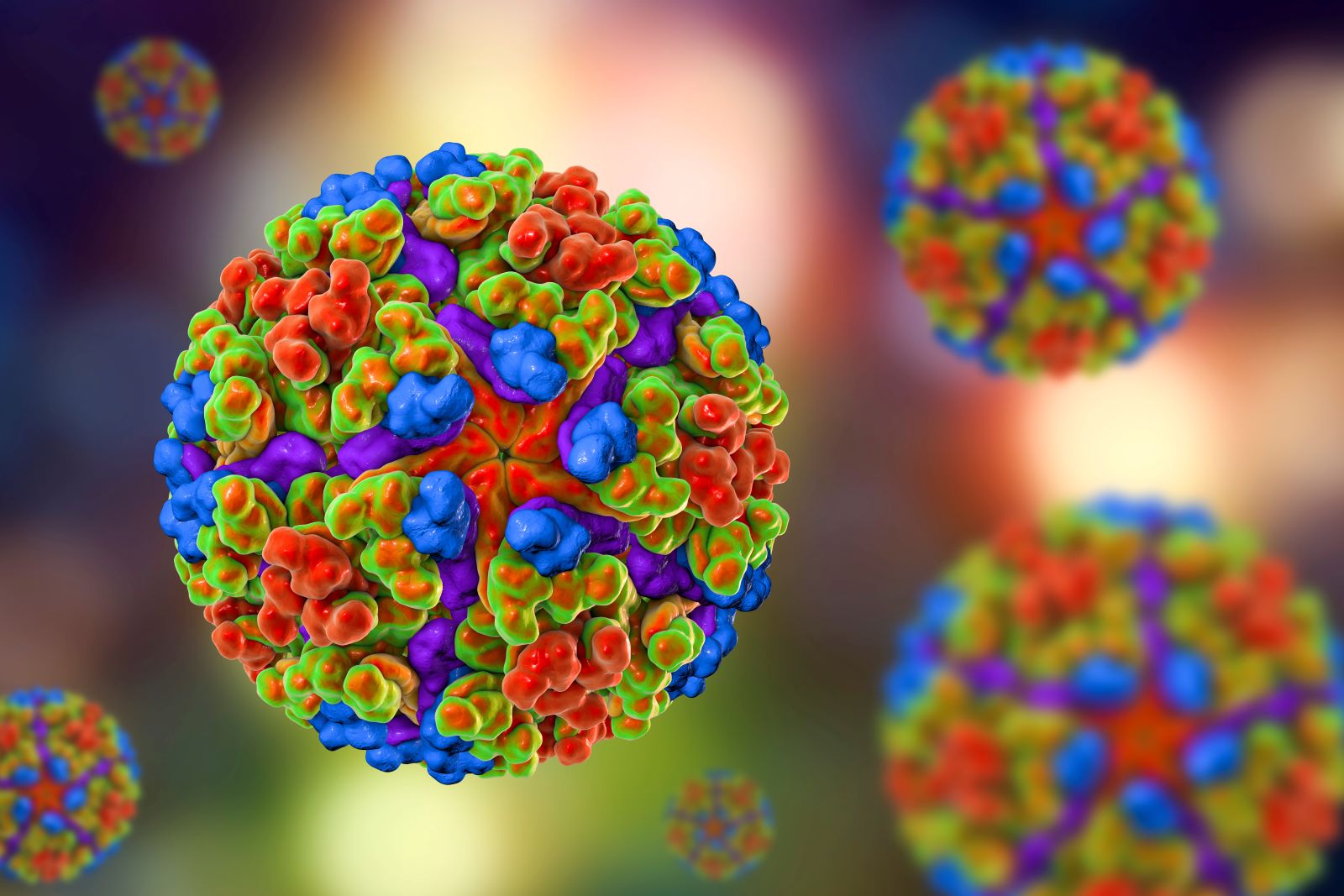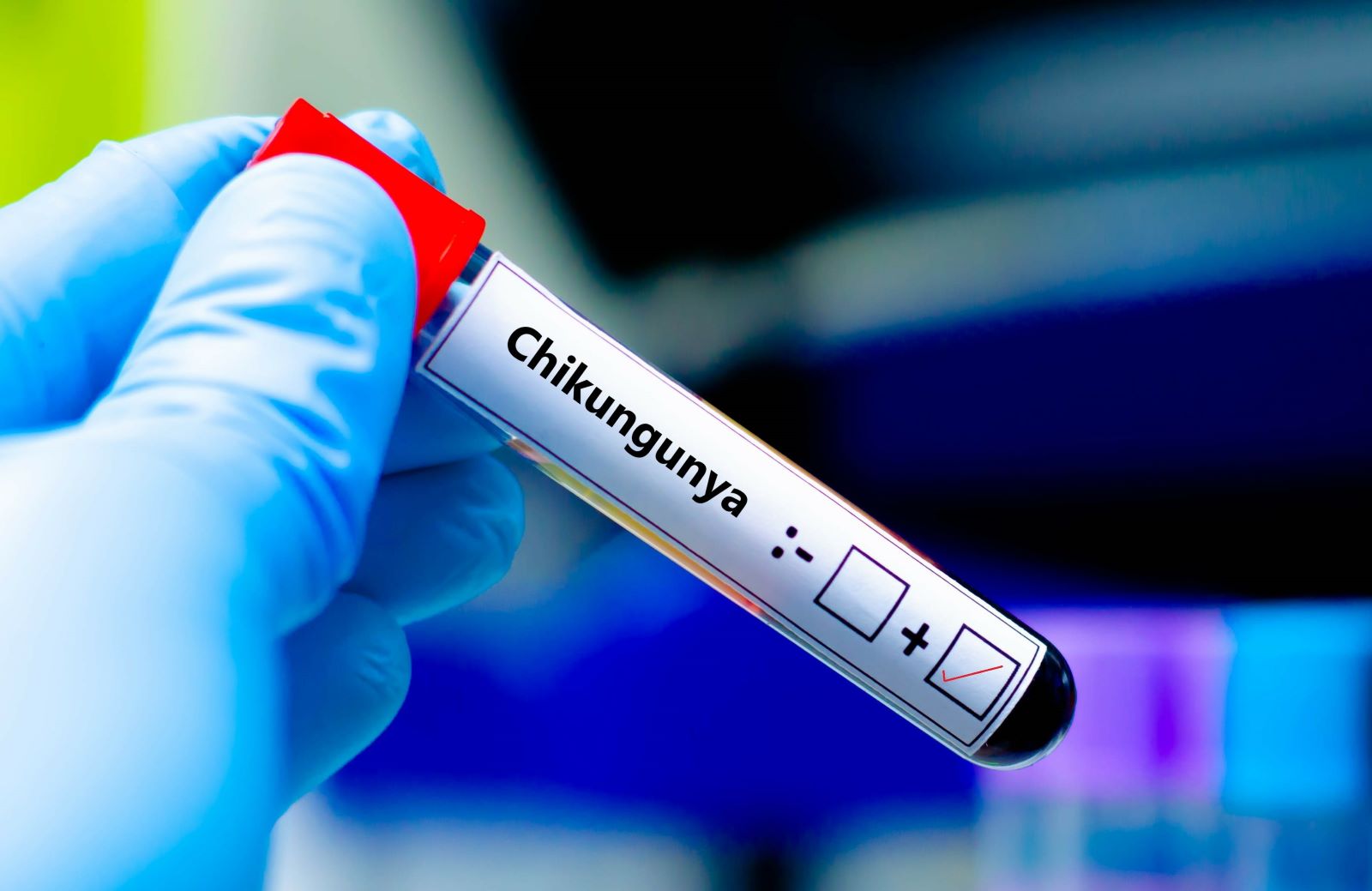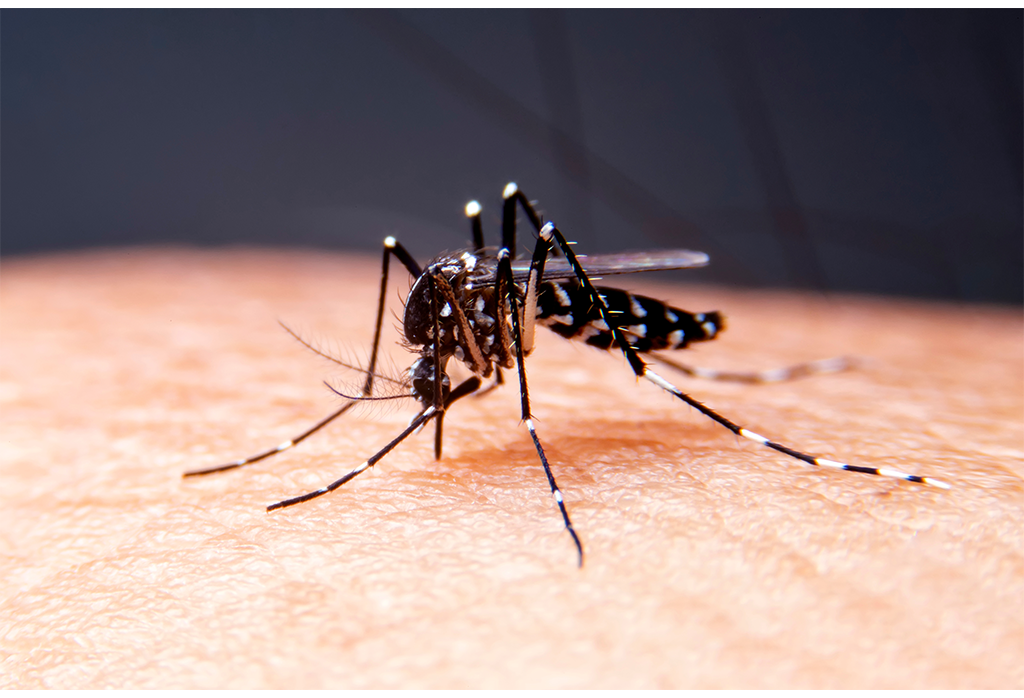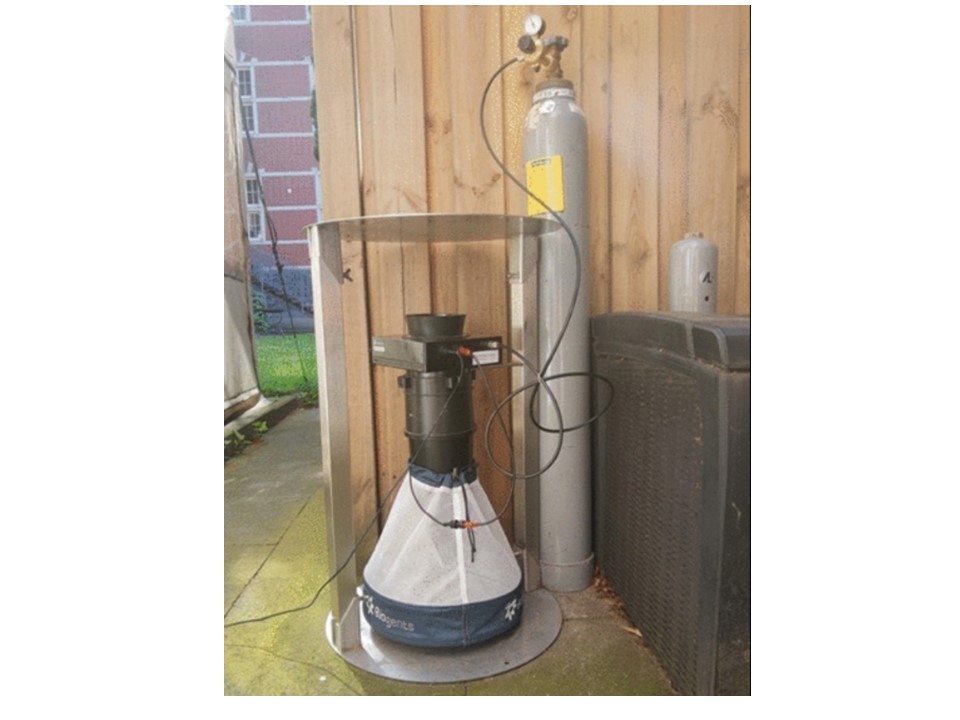
Chikungunya
Chikungunya is an infectious disease caused by an arbovirus, the chikungunya virus. Chikungunya can now be found in non-tropical regions, including Europe.
Last updated on 17 September 2025
In brief
- Chikungunya is an infectious disease caused by an arbovirus, the chikungunya virus. Rarely fatal, it causes fever and severe joint pain.1
- There are currently no approved specific treatments.
- With the spread of mosquito vectors, chikungunya can now be found in non-tropical regions, including Europe.1
Origin of chikungunya
History
This disease of African origin, whose name means ‘to become contorted’, causes muscle and joint pain. First identified in Tanzania in 1952, the chikungunya virus has since been the cause of numerous epidemics in over 110 countries in Asia, Africa, Europe and the Americas.1
The first urban outbreaks were recorded in Thailand in 1967 and in India in the 1970s.1 Since 2004, with the spread of the Aedes albopictus (tiger) mosquito vectors, outbreaks have become more frequent and more widespread.1 Between January and 30 November 2024, around 480 000 cases had been confirmed, mostly in South America – and more particularly in Brazil, which recorded had 203 deaths.2
Between August 2024 and 14 January 2025, a total of 192 indigenous cases of chikungunya had been confirmed on Reunion Island.3 Originally from South-East Asia, the tiger mosquito has reached Europe. After being isolated in Albania in 1979 and in Italy in 1990, it established itself in the south of France in 2024 and has been gradually spreading since then.4
Aedes albopictus has been found on Reunion Island and in 78 mainland departments of France since 1 January 2024.5
Chikungunya virus
Chikungunya virus (CHIKV) is an RNA virus belonging to the Togaviridae family and the genus Alphavirus. There are currently four evolutionary lineages: West African, Asian, East-Central-South African and Indian Ocean.6
Transmission
Mosquito bite transmission
Chikungunya is mainly transmitted to humans by mosquitoes of the genus Aedes, whose species differ according to zone: Aedes furcifer and Aedes africanus in Africa – according to a sylvatic and rural cycle; Aedes aegypti and Aedes albopictus in Asia – according to a somewhat urban cycle.7 All regions where populations of Aedes aegypti or Aedes albopictus are established are now seeing local transmission by mosquitoes, including in Europe.1
Aedes aegypti and Aedes albopictus can also transmit the dengue and Zika viruses.1 Females lay their eggs in habitats where the presence of stagnant water is necessary for larval development.4
After a female mosquito has fed on the blood of an infected person, which is necessary for egg maturation, the virus then replicates in the mosquito for around 10 days.4 After these 10 days, the infectious mosquito can transmit the virus and infect someone else.4
Maternal transmission
Vertical transmission from mother to child in the second trimester of pregnancy has also been documented, as well as intrapartum transmission when the mother was viraemic at the time of delivery.4,8
Transmission through products of human origin
Transmission can occur in exceptional cases by contact with infected blood, particularly in laboratory and healthcare personnel, but no cases of transmission by blood transfusion have been reported so far.8
Diagnosis
The viraemic phase begins around one to two days before the onset of the clinical signs and lasts up to seven days later.4
Diagnosis is primarily by PCR, which should be performed as soon as possible after the onset of symptoms (viraemia +/-8 days). At a later stage, presumptive diagnosis can be made in an epidemic context based on the presence of immunoglobulin M (IgM) and/or the detection of seroconversion (appearance of IgG) between two successive samples.9

Symptoms and treatment
Symptoms
CHIKV infection is most often symptomatic in 80% of cases. It usually progresses in three clinical stages: the acute stage – from D1 to D21, the post-acute stage – from D21 to 3 months, and the chronic stage – which extends beyond 3 months.10 Not all patients experience the post-acute and chronic stages.10
The first symptoms may be non-specific: fever, headache, rash and myalgia (muscle pain). However, the presence of intense arthralgia (joint pain), predominant at the extremities of the limbs, is highly suggestive. As these symptoms overlap with other infections, including those caused by the dengue and Zika viruses, cases can lead to misdiagnosis.1
The post-acute stage, dominated by the persistence of joint pain, affects more than half of patients, with an increased incidence after 40 years of age and in women.10 Those at risk of severe forms are people with comorbidities, pregnant women, immunocompromised individuals and people at extreme ages of life.
The chronic forms, which have a significant impact on quality of life, affect 20-60% of patients depending on viral lineage and quality of care received.11 An association with Guillain-Barré syndrome has also been described.12
The mortality rate associated with the severe forms ranges from 0.02% to 0.8%.13
After recovery, the immunity acquired against future infections appears to be lasting.1,10
Treatments
There are currently no approved specific treatments for CHIKV. Care is based on addressing the rheumatological symptoms and complications. Pain and fever are treated with analgesics.4,14 Patient care worldwide is based on French guidelines issued in 2014 under the coordination of Prof. Fabrice Simon at the request of the French Directorate General of Health (DGS).14
In addition to rest, patients should drink plenty of fluids to combat dehydration.1,10,14
The outcome can be rapidly favourable if the patient responds well to symptomatic treatment.15
- Avenues for research
Recent research on antiviral agents for CHIKV has explored a variety of approaches, including small-molecule inhibitors and monoclonal antibodies that have antiviral effects by targeting both the non-structural and structural proteins of the virus. Over the past decade, more than 30 potential agents have been patented, but none has as yet completed development or reached market.16
However, many treatments currently in development have shown encouraging results in vitro.17-21 Ethyl palmitate,17 lobaric acid18 and 8-bromobaicalein19 have shown reduced viral replication in Vero cells, as well as the hepatitis C agent sofosbuvir,20 the influenza agent favipiravir and the interfering RNA (siRNA)* Chik-1 and Chik-5.21
The combined use of antivirals could weaken the viral escape mechanisms.22 However, in a more original way, a globally recognised expert group has recently proposed a strategy of potentiating in vitro and in vivo an association of molecules already used in the clinic, and which individually have limited antiviral effects.23
EVT894, a promising human monoclonal antibody that targets a viral protein, has shown potent neutralising activity in in vitro and in vivo models. A Phase I, randomised, double-blind, single-dose escalation study of EVT894 vs placebo in healthy volunteers is currently ongoing and funded by the National Institute of Allergy and Infectious Diseases (NIAID).24
Additional trials and clinical studies are required before any therapeutic application.
* Short interfering RNA (siRNA) have major therapeutic potential: they play a role in regulating protein production by preventing the translation of messenger RNA into protein
Prevention
Vaccines
IXCHIQ is the only vaccine approved for chikungunya. Developed by the pharmaceutical company Valneva, it is a live, attenuated vaccine administered in a single dose by the intramuscular route. It received marketing authorisation from the US Food and Drug Administration (FDA), in November of 2023, and the European Medicines Agency (EMA), in July of 2024, for non-immunosuppressed individuals 18 years of age and older, with the exception of pregnant women.
On 27 February 2025, the French National Authority for Health (HAS) recommended that priority be given to vaccinating people at risk of severe forms of the disease who have never had a clinical or biological diagnosis, particularly those aged 65 and over, especially those with co-morbidities.
On 22 August 2025, the FDA suspended the use of IXCHIQ in the United States after four cases of serious adverse effects. More than 20 cases of serious adverse effects have been reported worldwide, mainly in France and the United States.
A phase 3 clinical trial involving 4 128 adults to evaluate the safety of the vaccine and 362 to evaluate its immunogenicity (ability to elicit an immune response), reported a 99% rate of seroconversion* of neutralising antibodies** four weeks after vaccination. This rate remained stable (98%) up to 6 months, regardless of age.25
- Avenues for research
A second subunit vaccine for CHIKV, developed by Bavarian Nordic, is being evaluated by the FDA and EMA.26
It was administered as an intramuscular dose in two phase 3 clinical trials involving 3 254 people between 12 and 65 years of age. The results showed a seroconversion rate greater than 97% after three weeks and 86% after six months (seroconversion was 82% in a second study involving 413 participants). The reactogenicity of this vaccine (its ability to produce side effects) is lower than that of IXCHIQ.27 In addition, several chikungunya vaccine candidates are in development including an inactivated Indian vaccine developed under the aegis of CEPI.28
Surveillance
Prevention remains the best way to control chinkungunya.1 To prevent and manage the risks associated with vector-borne diseases, the authorities have implemented vector surveillance and control measures.5
‘Active’ entomological surveillance is performed by the operators tasked with vector control. In 2018, a total of 4 006 egg-laying traps – a black bucket containing water, a cloth strip and a larvicide – were distributed across mainland France.5
Since 2014, this surveillance has been supplemented by ‘passive’ entomological surveillance in which everyone can participate by reporting the presence of tiger mosquitoes.5 This reporting provides a better understanding of its presence and helps define effective vector control.
Epidemiological surveillance of chikungunya has also been implemented, as part of the measures to combat arboviruses.29 Chikungunya is a notifiable disease across mainland France and throughout the year.30 The document required to report a case is available on the Santé publique France website.
The reporting criteria are sudden onset fever (> 38.5°C), debilitating joint pain and at least one of the following laboratory criteria: positive PCR OR positive IgM OR seroconversion OR increase (x 4) in IgG on two samples taken some time apart.29
Vector control
Vector control consists of eliminating larval habitats and adopting personal protective measures such as the use of repellents applied to the skin, mosquito nets and the wearing of long and loose clothing. Chemical control with the use of adulticide insecticides remains so far the main lever for rapidly reducing mosquito populations.31
*development of a specific antibody in the blood after vaccination.
**antibody that defends the body against a virus.
Research: The actions of ANRS MIE
ANRS MIE research priorities
- Vaccination
This is an identified priority for which a working group was set up in December 2024. In this domain, it is important to conduct studies on:
- The clinical efficacy of the vaccine, primarily in the different populations at risk.
- The duration of immunity conferred by the vaccine and the possible need for booster doses (primarily in populations at risk).
- Potential rare or serious side effects in children and immunosuppressed patients.
- Studies in the human and social sciences to identify potential barriers to the acceptance and implementation of vaccination.
Discussions have been underway between ANRS MIE and various research stakeholders since early December 2024 to establish a research protocol to evaluate the real-world vaccine efficacy of IXCHIQ. The methodology is currently being developed and will depend on potential vaccine recommendations issued by the French National Authority for Health (HAS). ANRS MIE is in contact with the HAS, which is aware of the launch of this project (in close collaboration with the DGS).
- Identification of early predictive biological factors and markers
Another priority area of research concerns the identification of early biological factors and markers that could be predictive of severe acute and delayed forms of chikungunya. In addition to factors already identified such as age and comorbidities, cohort studies must be conducted to determine the demographic, clinical, biological, virological, immunological and genetic factors associated with severe forms. ANRS MIE is in the process of setting up a new cohort with players on Reunion Island based on previous experience and the existence of a cohort in the French West Indies.
- Treatments
Research into antivirals and antibodies must continue in order to validate new viral targets and optimise treatment combinations.
- Prevention
Early surveillance of arbovirus circulation is crucial to prevent epidemics. The development of integrated systems combining entomological, clinical and environmental surveillance could transform the management of arboviruses. The most active segment at this stage is entomo-virological surveillance, which has the potential to make close surveillance of the entomological sector feasible in the very short term for CHIKV, which is currently unattainable by traditional techniques. Furthermore, the emergence of artificial intelligence offers interesting prospects in the medium term for the identification of mosquito species, the counting of populations and the analysis of spatial data
Vector control remains fundamental to limit the transmission of arboviruses. Innovative techniques, such as use of the Wolbachia* bacterium and the release of sterile insects, represent promising avenues, with the next stage being the evaluation of their efficacy.
A study conducted thanks to an Arbo-France thesis grant funded by ANRS MIE aims to understand the link between exposure to insecticides and the effectiveness of blocking the replication of dengue induced by Wolbachia in Aedes aegypti. Similar studies are envisaged on Reunion Island where Ae. albopictus is the main vector of CHIKV.
* a bacterium naturally present in many insects that prevents CHIKV from developing in the vector
Arbo-France network
Placed under the aegis of ANRS MIE, Arbo-France is a French multidisciplinary and multi-institutional network for human and animal arbovirus intelligence, surveillance and research on the mainland and overseas territories.
Its main objectives are to:
- create an intelligence and alert system with ANRS EID,
- improve the visibility of arbovirus research in France and abroad,
- help with the set-up of research projects,
- provide scientific expertise.
Various innovative approaches are being studied for the surveillance of CHIKV and other arboviruses, including the analysis of stagnant and wastewater and the use of artificial intelligence.22,32 Wastewater surveillance work is being conducted in French Guiana as part of the Arbo-France Innovative Surveillance of Arboviruses Think Tank. The Think Tank is also proposing the deployment of innovative entomo-virological surveillance based on the molecular identification of the virus in mosquito excreta in ad hoc traps.33 This approach has recently been proven for the surveillance of West Nile virus and dengue.
ANRS MIE thesis grants
The often limited efficacy of conventional insecticides is becoming increasingly compromised due to the limited availability of the molecules and the resistance of mosquitoes. New innovative approaches are being developed, including sterile insect techniques (SIT) and Wolbachia-induced incompatible insect techniques (IIT). These approaches are the subject of two thesis grants funded by ANRS MIE as part of the actions of the Arbo-France network.
Franco-Brazilian scientific cooperation
Drawing on their complementary areas of expertise, Brazil and France are mobilising to share their knowledge and develop joint projects around arboviruses, including chikungunya. On 30 and 31 October 2024, a Franco-Brazilian workshop on the theme of arboviruses was held in Belém (Brazil), organised by Instituto Evandro Chagas (Secretariat for Environmental and Health Surveillance, Ministry of Health of Brazil) and ANRS MIE, with the support of the French Embassy in Brazil and in partnership with the Arbo-France network.
ANRS MIE activated a level 1 emergence unit on 16 January 2025 in response to developments in the chikungunya situation in La Réunion.
References
- Chikungunya. https://www.who.int/fr/news-room/fact-sheets/detail/chikungunya. (consulté le 15/01/2025)
- European Centre for Disease Prevention and Control. Chikungunya worldwide overview. https://www.ecdc.europa.eu/en/chikungunya-monthly. (consulté le 15/01/2025)
- Point sur la situation du chikungunya à La réunion. https://www.lareunion.ars.sante.fr/point-sur-la-situation-du-chikungunya-la-reunion-2. (consulté le 14/01/2025)
- Santé publique France. Chikungunya. https://www.santepubliquefrance.fr/maladies-et-traumatismes/maladies-a-transmission-vectorielle/chikungunya/la-maladie/#tabs. (consulté le 15/01/2025)
- Le moustique tigre. https://www.anses.fr/fr/content/le-moustique-tigre. (consulté le 15/01/2025)
- Krambrich J, et al. The evolutionaryand molecular history of a chikungunya virrus outbreak lineage. PLoS Negl Trop Dis 18(7): e0012349. https://doi.org/10.1371/journal.pntd.0012349. (consulté le 15/01/2025)
- Consigny H, et al. Infection par le virus Chikungunya : une alphavirose ré-émergente. Médecine/Sciences 2006 ; 22 : 444-6. https://www.medecinesciences.org/en/articles/medsci/full_html/2006/05/medsci2006224p444/medsci2006224p444.html. (consulté le 15/01/2025)
- Gimenez-Richarte A, et al. Transfusion-transmitted arboviruses: Update and systematic review. PLoS Negl Trop Dis 16(10): e0010843. https://doi.org/10.1371/journal.pntd.0010843. (consulté le 15/01/2025)
- Pezzi L, et al. GloPID-R report on Chikungunya, O’nyong-nyong and Mayaro virus, part I: Biological diagnostics. Antiviral Res 2019 ;166 :66-81. https://www.sciencedirect.com/science/article/pii/S016635421930124X?via%3Dihub. (consulté le 15/01/25)
- Recommandations nationales sur la prise en charge du chikungunya (Formes aiguës, formes persistantes). Réponse à la saisine de la Direction Générale de la Santé du 18/07/2014. Novembre 2014. https://sante.gouv.fr/IMG/pdf/2014-Chikungunya-recommandations_SPILF_2014.pdf. (consulté le 15/01/2025)
- Avis du Comité de Veille et d’Anticipation des Risques Sanitaires (COVARS) du 3 avril 2023 sur les risques sanitaires de la dengue et autres arboviroses à AEDES en lien avec le changement climatique. avis-du-covars-du-3-avril-2023—risques-sanitaires-de-la-dengue-du-zika-et-du-chikungunya-en-lien-avec-le-changement-climatique-27356.pdf (consulté le 22/01/2025)
- Stegmann-Planchard S, et al. Chikungunya, a risk factor for Guillain-Barré syndrome. Clin Infect Dis 2020;70(6):1233-1235. https://academic.oup.com/cid/article/70/6/1233/5530547?login=false (consulté le 22/01/2025)
- Bartholomeeusen K, et al. Chikungunya fever. Nat Rev Dis Primers 2023;9(1):17. Chikungunya fever. (consulté le 17/03/25)
- Recommandations nationales sur la prise en charge du chikungunya (formes aiguës, formes persistantes), Spilf 2014. https://sante.gouv.fr/IMG/pdf/2014-Chikungunya-recommandations_SPILF_2014.pdf. (consulté le 15/01/25)
- Ministère de la santé et de l’accès aux soins. https://sante.gouv.fr/soins-et-maladies/maladies/maladies-vectorielles-et-zoonoses/article/chikungunya. (consulté le 15/01/2025)
- Ghildiyal R, Gabrani R. Antiviral therapeutics for chikungunya virus. Expert Opin Ther Pat 2020;30(6):467-480.
- Sagna A, et al. Ethyl palmitate, an anti-chikungunya virus principle from Sauropus androgynus, a medicinal plant used to alleviate fever in ethnomedicine. J Ethnopharmacol 2023:309:116366.
- Feibelman KM, et al. Identification of small molecule inhibitors of the Chikungunya virus nsP1 RNA capping enzyme. Antiviral Res 2018:154:124-131. https://pmc.ncbi.nlm.nih.gov/articles/PMC5966835/. (consulté le 15/01/2025)
- Badshah SL, et al. Antiviral activities of flavonoids. Biomed Pharmacother 2021:140:111596. https://www.sciencedirect.com/science/article/pii/S0753332221003814?via%3Dihub. (consulté le 15/01/2025)
- Ferreira AC, et al. Beyond members of the Flaviviridae family, sofosbuvir also inhibits Chikungunya virus replication. Antimicrob Agents Chemother 2019;63(2):e01389-18. Beyond Members of the Flaviviridae Family, Sofosbuvir Also Inhibits Chikungunya Virus Replication | Antimicrobial Agents and Chemotherapy. (consulté le 15/01/2025)
- Parashar D, et al. Administration of E2 and NS1 siRNAs inhibit Chikungunya virus replication in vitro and protects mice infected with the virus. PLoS Negl Trop Dis 2013;7(9):e2405.
- Wang M, et al. Drugs targeting structural and nonstructural proteins of the chikungunya virus: A review. Int J Biol Macromol 2024;262(Pt 2):129949.
- Verwimp S, et al. Combinations of approved oral nucleoside analogues confer potent suppression of alphaviruses in vitro and in vivo. bioRxiv. 2025:2025.01.24.633564. https://www.biorxiv.org/content/10.1101/2025.01.24.633564v1. (consulté le 15/01/2025)
- Evotec Starts Clinical Development of Chikungunya Antibody together with NIAID and Leading Academic Research Organisation. https://www.evotec.com/en/news/evotec-starts-clinical-development-of-chikungunya-antibody-together-with-niaid-and-leading-academic-research-organisation . (consulté le 15/01/2025)
- Schneider M, et al. Safety and immunogenicity of a single-shot live-attenuated chikungunya vaccine: a double-blind, multicentre, randomised, placebo-controlled, phase 3 trial. Lancet 2023;401(10394):2138-2147. https://www.thelancet.com/journals/lancet/article/PIIS0140-67362300641-4/fulltext. (consulté le 15/01/2025)
- Bavarian nordic. Bavarian Nordic submits marketing authorization application for its chikungunya vaccine candidate to EMA. https://www.bavarian-nordic.com/investor/news/news.aspx?news=6961. (consulté le 15/01/2025)
- Richardson JS, et al. 2888. Safety and immunogenicity of an adjuvanted Chikungunya virus (CHIKV) Virus-like Particle (VLP) based vaccine in two pivotal phase 3 trials, ≥12 years of age. Open Forum Infect Dis 2023 ;10(2), ofad500.2471, https://doi.org/10.1093/ofid/ofad500.2471. (consulté le 15/01/2025)
- Bharat Biotech. Research areas. https://www.bharatbiotech.com/research_areas.html. (consulté le 15/01/2025)
- Santé publique France. Chikungunya : notre action. https://www.santepubliquefrance.fr/maladies-et-traumatismes/maladies-a-transmission-vectorielle/chikungunya/notre-action/#tabs. (consulté le 15/01/2025)
- Santé publique France. Liste des maladies à déclaration obligatoire. https://www.santepubliquefrance.fr/maladies-a-declaration-obligatoire/liste-des-maladies-a-declaration-obligatoire. (consulté le 15/01/2025)
- Anses. La lutte anti-vectorielle, des stratégies multiples contre les vecteurs. https://www.anses.fr/fr/content/la-lutte-anti-vectorielle-des-strategies-multiples-contre-les-vecteurs. (consulté le 15/01/2025)
- Wang M, et al. Enhancing vector control: AI-based identification and counting of Aedes albopictus (Diptera: Culicidae) mosquito eggs. Parasit Vectors 2024;17(1):511. https://parasitesandvectors.biomedcentral.com/articles/10.1186/s13071-024-06587-w. (consulté le 15/01/2025)
- Bigeard C, et al. Molecular Xenomonitoring (MX) allows real-time surveillance of West Nile and Usutu virus in mosquito populations. Plos Neg Trop Dis 2024 : https://journals.plos.org/plosntds/article?id=10.1371/journal.pntd.0012754. (consulté le 15/01/2025)


